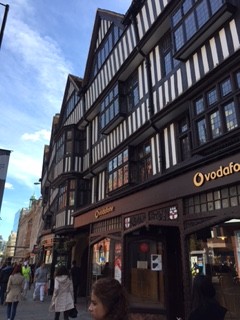Legal London or Latent London?
All of our first year law undergrads took part in an exercise in week one of their LLB where they escaped City and went to visit a number of buildings of significance in the local area, before tackling some research questions.
They were then asked to write a blog post inspired by their travels. 21 winners were selected from all those posts submitted – this is one of those – thanks to Zahrah Latief.
Fleet Street. If I was to tell you to pull a random person out of a crowd right now, and ask them what Fleet Street is, their response would be wonderfully inevitable: “it’s that place on Monopoly”. And for the vast majority of us ordinary folk, that’s exactly what it is. But our journey to the widely known location as Law undergraduates, rather than mere passers-by or players of a popular board game, told us a different story altogether. Named after the River Fleet, London’s largest underground river, Fleet Street is thought to have been around as early as the 13th Century. Finding the place itself was not particularly difficult, but we certainly found more than we bargained for when we unearthed the rich vein of courts and bars, with an even richer vein of back-story.
Once the property of the Knights Templar, a powerful Western Christianity military order, there is an area of legal buildings towards the south of Fleet Street, known simply as The Temple. Towards the east is the Old Bailey, and the to the west, The Royal Courts of Justice, which we stopped by to visit and ask some questions. Achieving the impressive feat of being one of the largest courts in Europe, the architecture, in all its magnificence, was designed by George Edmund Street, who died before the building’s completion. The history, and the thousands of stories that would have weaved in and out of The Royal Courts of Justice since it’s inception, make it overwhelming to be around, and I can only imagine the variety people who pushed through the heavy doors before me.
Fleet Street does not only house courts and legal buildings, however. Funnily enough, it turns out that all work and no play makes lawyers unhappy too. Where does a troubled lawyer go after a long day in the office? There’s only one answer to this, and I’m sorry to disappoint, but it’s not a punch line. After a long day, it seems only fitting that lawyers, just like the rest of us simpletons, find solace in a warm tavern, embracing a cold pint. It follows that our next location to visit, or rather rely on Google Maps to lead us to, was the curiously charming El Vino’s wine bar.
Much like a fine wine, the place is beautiful and aged from the outside, and it serves as no shock that for years, El Vino’s has been the choice haunt for drinkers in legal London to frequent. So what is it about this particular bar that struck our fancy? Well, it’s a little something that I can dramatically encapsulate in the heading: Gill v El Vino: A Fight for Feminism?
So, what happened?
The year was 1983. The city was London. The bar was warm, and dimly lit. This isn’t a dramatic showdown from a classic Western, however. It’s a very real, and infamous, case that took place when solicitor Tess Gill and journalist Anna Coote courageously defied the rules that had seldom been confronted with challenge in the past. In order to uphold “old fashioned ideals of chivalry”, El Vino’s had placed a ban on women drinking at the bar. A woman? At a bar? Absurd. I can’t imagine why anyone would have any problem with such a courteous gesture! But for Mrs Gill and Ms Coote, perhaps the day had been a little too long, and enough was most certainly enough. They demanded to be served their wine at the bar, and when denied, they took El Vino’s to court.
When I researched the case, I couldn’t help but feel remnants of a certain Rosa Parks shining through, with the same obstinate demand for equality that would simply not budge. Perhaps reference to the latter is a reach, but it goes without saying that the resilience and spirit of the two ladies is commendable and worthy of some serious applause. When the case of Gill v El Vino was taken to the Court of Appeal, the lifetime ban on Gill and Coote was lifted; it was a victory for feminism and equal rights, and a slap in the face for outdated patriarchal beliefs in a male dominated society. The Guardian covered an article on the 30th anniversary of the story, perhaps to remind readers that true conviction in an admirable ideal is always worth fighting for. Or it could have been a slow news day. I prefer my explanation more, anyway.
Interested in finding out more about this case? See Amy Woolfson’s piece on ‘3 cases that defined women’s rights in the UK and beyond‘ and the 30th anniversary article in The Guardian.


